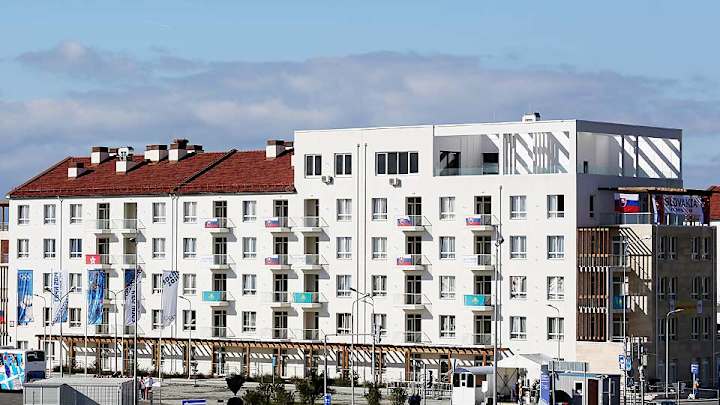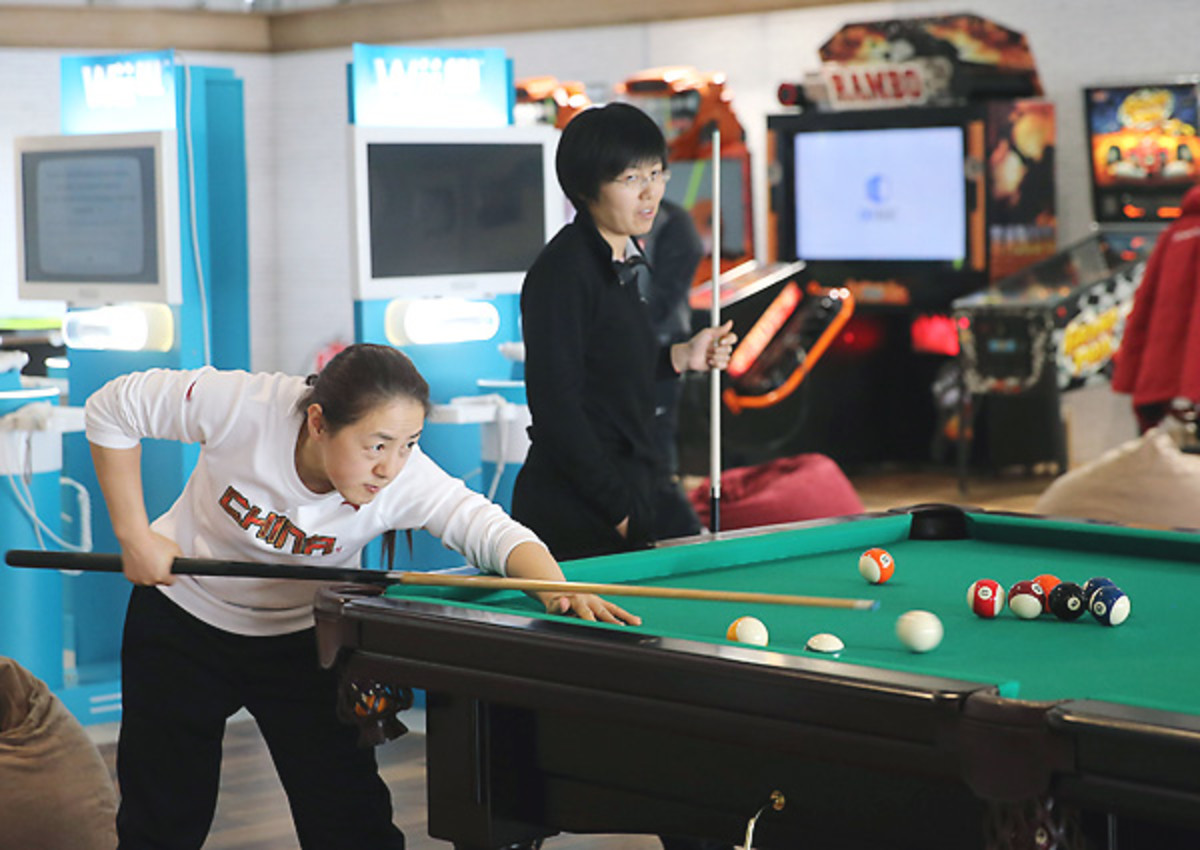Inside the Olympic Village in Sochi

Welcome to the athletes' village at the Olympics. This is one of two constructed to house the roughly 3,000 athletes and nearly as many officials and functionaries. It is where those playing starring and supporting roles at the Games will eat, sleep, stretch, fret and celebrate over their Olympic experience.
We are down in the so-called Coastal Cluster, where the ice sports are being held. The snow sports, located up in the Mountain Cluster, have their own accommodations.
There are buildings for athletes to eat, workout, get a haircut, trade pins, buy and mail a postcard, get a massage, watch other competitions on large-screen televisions or simply blow off steam. “We have a place with a disco library,” says Svetlana Zhurova, a former Russian speedskating star whose official title is mayor of the athlete village. “So you may have a dance or you may read a book or both.”
One building houses a giant fitness center with free weights, stationary bikes, chin-up bars, rowing machines, and even a fit ball with a face of a smiling misha bear.
The games room inside gives athletes a chance to relax or find competitive pursuits in which they seem quite human. One skater from Kazakhstan attempted a pool trick shot that went somewhat wrong and pelted a volunteer in the ribs with an errant 15 ball. To be fair, it didn’t miss the side pocket -- of the volunteer’s jacket -- by much.
Athletes can try their hands and feet at a 500-meter speed skating contest on a Wii machine. The words “Adler Arena” scrolled across the screen every few seconds and display the fastest times, which had been posted by the entrants Dr. Eggman, Peach and Ralph Sampson. Who knew the old Virginia Mountaineer could skate?
A pair of other Wii machines featured modified versions of snowboarding and freestyle skiing. The number of crashes and degree of incline seem to approximate the maligned slopestyle course in Sochi. One Hungarian athlete was displaying some questionable form and fairly colorful language in trying to ride the rails without spinning into the bushes. He finally gave up and convinced a coach to join him in a more predictable game of foosball.
Perhaps because most NHL players were still plying their trades in North America for their NHL teams, the air hockey game remained unused during our visit.
Eighties techno music blared from the back of the nearby disco/library, which sported an oddly shaped bookcase that displayed novels leaning against one another at unusual angles.
Available offerings could placate those with the sensibilities of the 10,000-meter speed skater or 50k cross-country skier (Tolstoy’s War and Peace) or the 500-meter skaters (any number of quickies from Stephen King). Other options included everything from the Scarlett Letter to the Great Gatsby to Dracula and the Three Musketeers. And would any library in the old Soviet Union ever have allowed the display of The Gulag Archipelago by celebrated dissident Aleksandr Solzhenitsyn? This one did.

The complex consists of 47 buildings containing apartments with anywhere from one to four bedrooms. Most have balconies and patios. Athletes from several countries have draped flags outside of several of the balconies. Slovenia and Slovakia have large flags -- the Slovenian one has seen better days before being twisted up by the wind -- and those from Norway and Spain are slightly smaller.
“That’s when you know you’ve arrived at the games,” says Charles Hamelin, a Canadian short track skater competing at his third Olympics. “When you see the flags and the athletes from other sports that you don’t usually see during the season, then you really feel like this is the Olympics. That’s why getting into the village makes it feel different than just a normal competition.”
The buildings lead to a park and lake with jogging and biking paths along the scenic seafront of the Black Sea. Somewhere out there, two U.S. navy ships, the U.S.S. Mount Whitney and the U.S.S. Taylor stand watch in case an incident causes an emergency evacuation of U.S. delegation members.
There are fewer flags here than at most Olympics, perhaps because of security warnings about athletes being too public with their country affiliations. No U.S. flags fly from the balconies, and there are no signs on the doors indicating that a particular building houses U.S. athletes. One journalist who had been speaking to a trainer from her local area was shooed away from the building by a delegation official.
Each nation has its own flag-raising ceremony inside the village, with delegation officials and athlete invited to attend, as the flags ascend poles and anthems are played. Russian President Vladimir Putin attended the Russian flag raising ceremony and proclaimed, “We count on you and place our hopes in you.”
The Indian team had been forbidden to raise its own flag during the opening ceremony because its Olympic committee was under suspension because of corruption. Athletes had to march into the stadium under the heading of Independent Olympic Participants. India was reinstated during the games and was due to have its flag raising ceremony at the village later in the week.
Australian athletes have a raised a mini-furor by raising a flag with a boxing kangaroo that has become a popular, but unofficial, flag in that country. Unauthorized flags are generally forbidden by the IOC and local organizers at the Games. When officials in Vancouver gave the Aussies a hard time over the flag draping at the last games, the folks down under defiantly flew one anyway. This year, the parents of David Morris, the world’s No. 2-ranked aerialist, began waving the flag in the stands during his competition, and Morris’ father nearly came to blows with a security guard who tried to take it away.
U.S. athletes have had mixed results at their village.
U.S. figure skater Jason Brown, a first-time Olympian, arrived in his room the first day to find that family members, teammates and officials had conspired to place a giant poster of him skating, above his bed and had also decorated the room’s other walls with family photos from his childhood. “It made me feel just like I was home,” Brown said.
Here’s hoping this bobsledder Johnny Quinn doesn’t repeat his village experiences at home. On Saturday, Quinn was locked in his bathroom and had to break a hole in his door in order to get out. Two days later, Quinn and two of his teammates, Nick Cunningham and David Cripps, got stuck in an elevator.
British bobsledder Rebekah Wilson had a close call last week when she hit the down button from the third floor of the village and saw the door open to a drop into an empty elevator shaft. Relieved she was paying attention, Wilson decided to walk.
The Olympic Village is an equalizer of sorts where no one athlete should expect better treatment than others. Even for the athletes who go swifter, higher and stronger as they reach for the stars, the village in Sochi can be a place where it pays to reach for the stairs.
